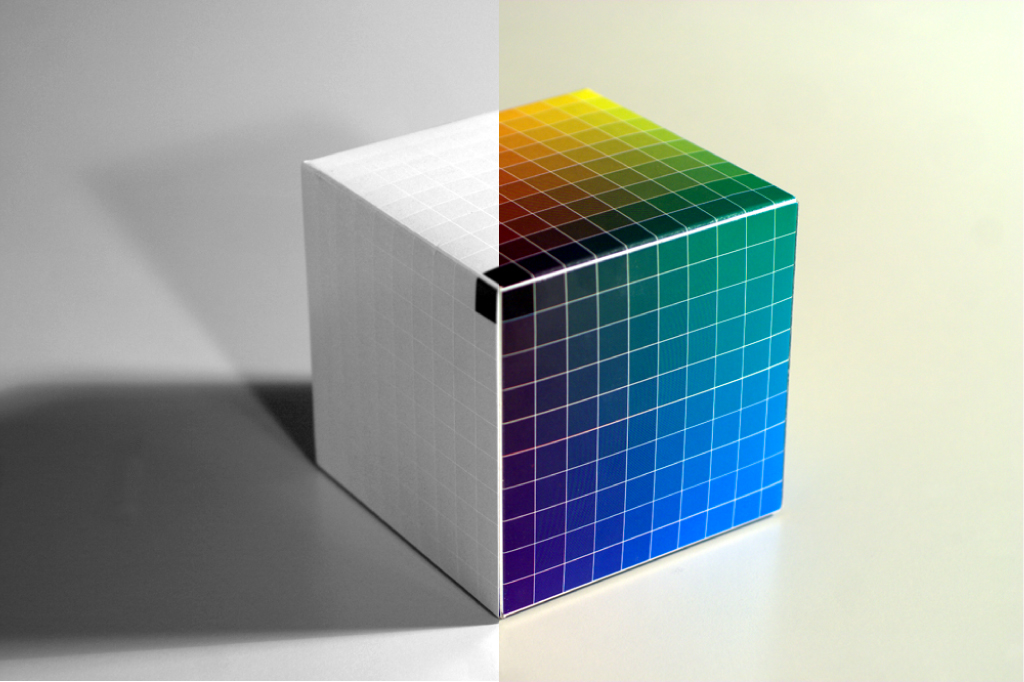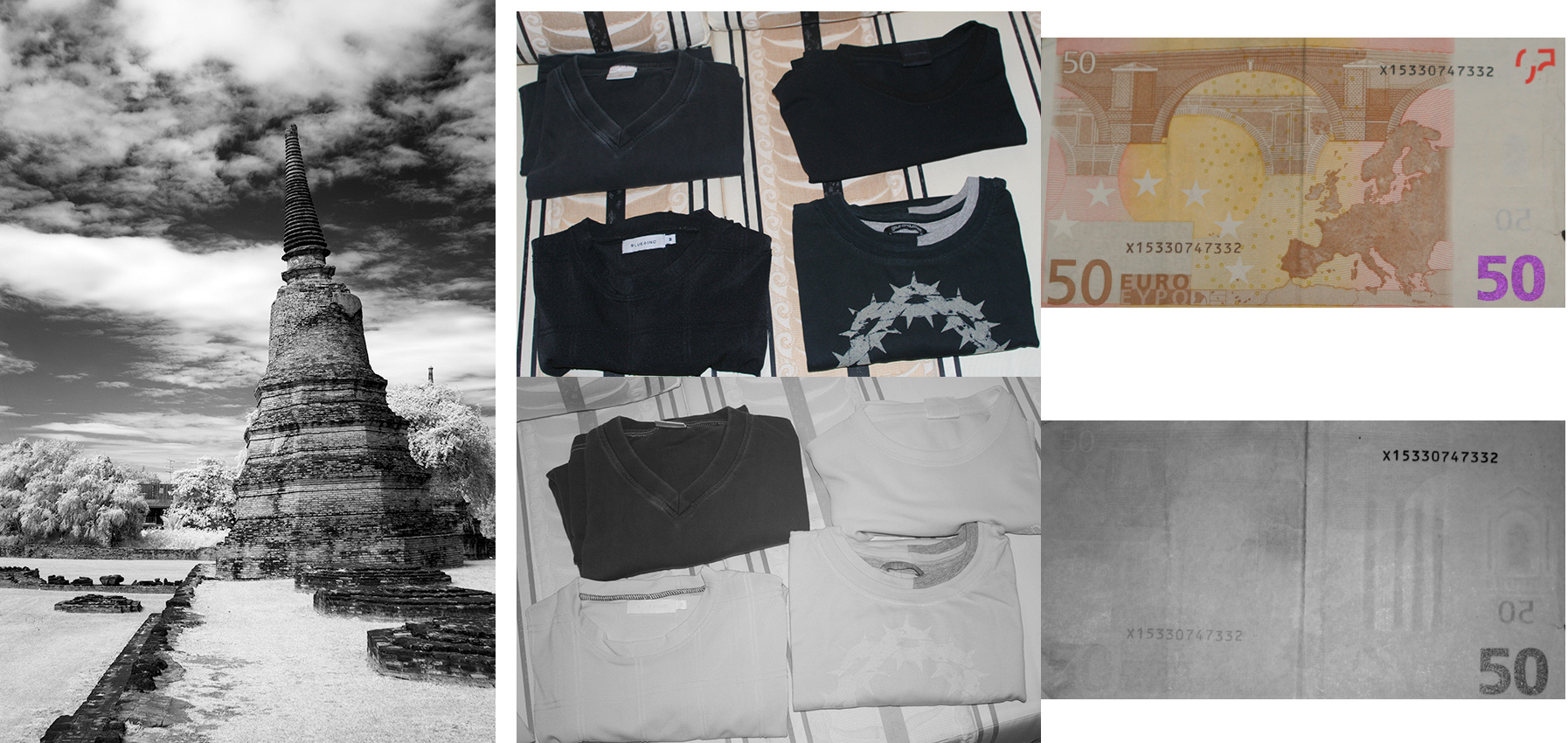Author
Clement Fredembach
Welcome to my (small) near-infrared page!
Here you will find a (short) introduction to near-infrared digital photography and to our work that make use of near-infrared and visible data. This page content will be regularly updated to incorporate what we learned and the work we have done.
As usual, you are welcome to use the material presented therein for your personal or (not for profit) research work if you are kind enough to acknowledge and reference our work (most of the images here are available at a higher resolution).
What is near-infrared?
How to capture near-infrared?
Why use near-infrared?
Related Publications
What is near-infrared?
The portion of the electromagnetic spectrum perceived by the human visual system is generally called the “visible spectrum” and ranges from (about) 380 to 700 nanometers in wavelength. The near-infrared spectrum is located just after the red wavelength and comprises wavelengths that range from 700 to 1100 nanometers (this latter boundary depends on the considered application. See this page for more information). Even though the NIR band is located next to the visible one, there is, in general, almost no correlation between a visible and NIR signal (i.e., knowing the colour and brightness of an object gives no information about its NIR response). High-frequency information, however, tends to be preserved, so a near-infrared image is easily interpreted by a human observer. All this can be seen in the RGB cube figure, half of it is in the visible, half in the near-infrared. The NIR response is completely independent of the colour, but the cube and shadow edges are clearly seen nonetheless. More details about near-infrared images are given here.
 A printed RGB cube. The NIR response doesn’t depend on the colour value, except for black, which is (in this case) made of NIR-absorbing pigments.
A printed RGB cube. The NIR response doesn’t depend on the colour value, except for black, which is (in this case) made of NIR-absorbing pigments.How to capture near-infrared?
While the human visual system is unable to capture near-infrared radiation, a camera can. Near-infrared films have been produced by a number of manufacturers but their use has always been limited to enthusiasts because of the precautions needed in operating them as well as the very long exposure times needed (up to a minute depending on the environment). Digital cameras on the other hand have silicon-based sensors that are very sensitive to NIR.
In fact, digital cameras’ sensors are so sensitive to near-infrared that a “hot mirror”, a filter that lets only visible light pass, is placed in front of them in order to prevent NIR contamination of the visible signal. As a result, a modification of the camera is needed to remove the hot mirror and replace it by either clear glass or a visible-blocking filter (in the latter case, the camera will only be able to capture near-infrared images). The first camera we have modified in such a manner was a Canon 300D SLR and we opted to replace the hot mirror by clear glass to be able to subsequently capture either visible or NIR images by placing a NIR-blocking or visible-blocking filter in front of the lens.
Modifying a camera in such a manner is not too difficult provided you have patience with small connectors and a guide that tells you what to expect at each step (google and youtube have “walkthroughs for a lot of different camera models). Also bring toothpicks, they make life much easier with some of the ribbon connectors.
 Some of the steps involved in modifying the camera. Alternatively, a number of shops sell already modified cameras (depending on the model, for 300 to 500USD above the camera’s retail price).
Some of the steps involved in modifying the camera. Alternatively, a number of shops sell already modified cameras (depending on the model, for 300 to 500USD above the camera’s retail price).Why use near-infrared?
There is a great deal of interest about near-infrared, both from a scientific and artistic perspective. Here are some applications that use NIR signal obtained from a digital camera.
In photography proper, NIR delivers sharp images with sometimes a dramatic outlook. Indeed, sky and water are black, clouds stay white, and vegetation becomes very bright. The reasons for these differences with the visible are, however, very diverse. In vegetation this is due to the cellular structure of the leaves; water absorbs near-infrared radiation; clouds are composed of droplets that scatter incoming light according to Mie’s law (the angle of scattering is independent of the wavelength); sky is dark for the same reason it is blue: very small particles scatter light but the scattering angle is proportional to the inverse fourth power of the wavelength (Rayleigh scattering), thus blue is the most scattered and near-infrared the least.
Rayleigh scattering is also the reason why, in landscape images, distant objects become blurred and have a blue colour cast. This phenomenon, atmospheric haze, is almost absent from near-infrared images, yielding haze-free images that have a larger optical depth.
Forgery prevention and material science use the fact that colour pigments can have decidedly different responses in the near-infrared, indeed a very large number of pigments are quasi-transparent to NIR light. This property actually allows a modified camera to capture NIR images. Recall that in order to have a colour image, a colour filter array (a mosaic of coloured filters) is placed in front of the sensor. If the pigments of the CFA did not transmit near-infrared in addition to colour, a hot-mirror would not be necessary and NIR imaging with a digital camera would be much more difficult to do (for a more detailed discussion about that point and the capture of monochromatic images, see [1] and [2]).
An example of such applications is secure printing. The image of the RGB cube illustrates that all colours have an identical near-infrared response, but black stays black due to the different pigment used. Using near-infrared can thus allow one to distinguish between the black obtained by black ink and the one obtained by the superposition of the colours. Specific colour inks can also be devised and are used as a security measure against the counterfeiting of bank notes.
Carefully choosing dyes also allows one to design warmer, or cooler, clothing. Everyone knows that, in the sunshine, a black garment is warmer to wear because it absorbs the sunlight, but this is true only to an extent. The black dye absorbs (with certainty) the part of the sun light that is emitted in the visible spectrum. The sun having a significant emission in the near-infrared, there can thus be a large difference in how warm a black item feels depending on its NIR absorption.
Other applications of near-infrared images include astronomical imaging, remote sensing (haze transparency and greater contrast between regions), biometrics (veins are more visible in the NIR) and face recognition.
 Some uses and applications of NIR images. Landscape images can appear more dramatic, black is not always black, and secure printing: some inks are transparent to NIR (try it with different banknotes, it works with most of them albeit with different patterns).
Some uses and applications of NIR images. Landscape images can appear more dramatic, black is not always black, and secure printing: some inks are transparent to NIR (try it with different banknotes, it works with most of them albeit with different patterns).Related Publications
[1] C. Fredembach and S. Süsstrunk, Colouring the near infrared, Proceedings of the IS&T 16th Color Imaging Conference, pp. 176-182, 2008.
Supplementary material (image pairs and enhanced ones).
[2] C. Fredembach and S. Süsstrunk, Illuminant estimation and detection using near infrared, SPIE/IS&T Electronic Imaging, Digital Photography V, 2009.
This is joint work with Prof. Sabine Süsstrunk, Dr. Yue M. Lu, and Zahra Sadeghipoor.